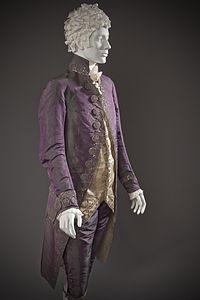Shot silk


Shot silk (also called changeant,[1] changeable silk, changeable taffeta, cross-color, changeable fabric,[2] or "dhoop chaon" ("sunshine shade")[3]) is a fabric which is made up of silk woven from warp and weft yarns of two or more colours producing an iridescent appearance.[4] A "shot" is a single throw of the bobbin that carries the weft thread through the warp,[4] and shot silk colours can be described as "[warp colour] shot with [weft colour]." The weaving technique can also be applied to other fibres such as cotton, linen, and synthetics.
History[edit]
A shot silk vestment of purple and yellow dating from about 698 is described in detail in a document written in about 1170, showing that the technique existed since at least the 7th century.[5] An argument has been made that shot silk was also described as purpura at this time, the Latin word mainly applied to purple although there are multiple references to purpura being red, green, and black-and-red, as well as "varied".[5] Purpura is also used to mean iridescence and the play of light, and contemporary descriptions exist indicating that the textile purpura was a type of silk distinct to other silks in assorted colours.[5] It has also been suggested that illuminations in the Lindisfarne Gospels of c.700 show garments of shot silk being worn by the Four Evangelists.[6]
Shot silks were popular in the 18th and 19th centuries, including warp printing, where the warp was printed before weaving to create chiné or "Pompadour taffeta".[7]
Current use[edit]
Shot silks are used today to make neckties and other garments. Notably, some forms of academic dress use shot silks, such as those of the University of Wales and the University of Cambridge. For example, the robes of a Cambridge Doctor of Divinity are faced with "dove" silk, which is turquoise shot with rose-pink to create an overall grey effect.[8][9]
See also[edit]
Notes[edit]
- ^ Franck, Robert R., ed. (2006). Silk, mohair, cashmere and other luxury fibres (Repr. ed.). Boca Raton: CRC. p. 31. ISBN 9781855735408.
- ^ Montgomery, Florence M. (1984). Textiles in America 1650-1870 : a dictionary based on original documents, prints and paintings, commercial records, American merchants' papers, shopkeepers' advertisements, and pattern books with original swatches of cloth. Internet Archive. New York ; London : Norton. p. 195. ISBN 978-0-393-01703-8.
- ^ India, Malkha. "CROSS COLOUR FABRIC : KORA : KATHA BROWN". Malkha India. Retrieved 18 August 2020.
- ^ a b Takeda & Spilker 2010, p. 49.
- ^ a b c Dodwell, C.R. (1982). Anglo-Saxon Art, A New Perspective. Manchester University Press. pp. 145–150. ISBN 0-7190-0926-X.
- ^ Owen-Crocker, Gale R. (2010). Dress in Anglo-Saxon England (Rev. and enl. ed.). Woodbridge: Boydell & Brewer. p. 302. ISBN 9781843835721.
- ^ Fukai, Akiko (2002). Fashion : the collection of the Kyoto Costume Institute : a history from the 18th to the 20th century. Köln [etc.]: Taschen. p. 56. ISBN 9783822812068.
- ^ "Gowns and Hoods". University of Wales. Retrieved 9 April 2011.
- ^ Statutes and Ordinances of the University of Cambridge 2015. Cambridge University Press. 2015. ISBN 9781107531468. Retrieved 8 May 2017.
References[edit]
- Takeda, Sharon Sadako; Spilker, Kaye Durland (2010). Fashioning Fashion: European Dress in Detail, 1700–1915. Prestel USA. ISBN 978-3-7913-5062-2.


 French
French Deutsch
Deutsch